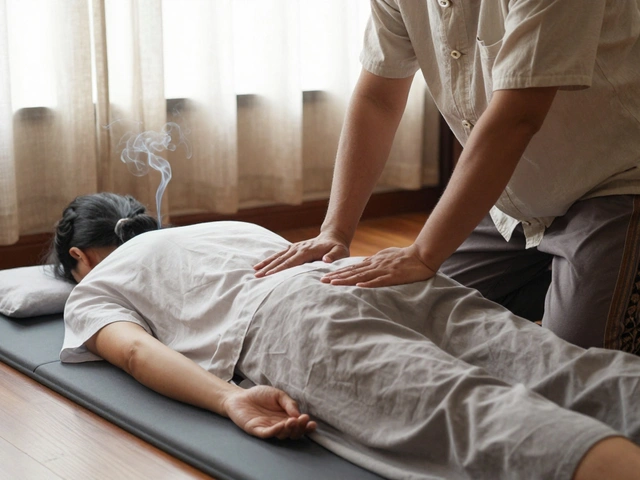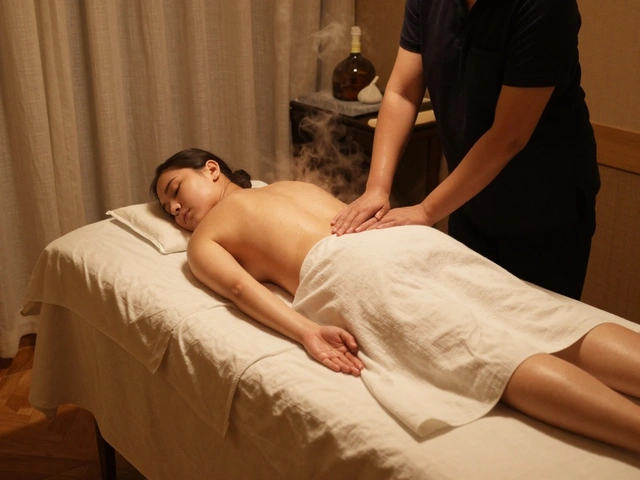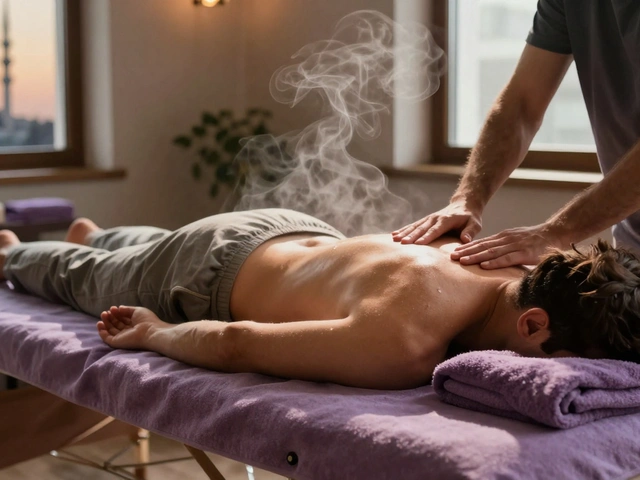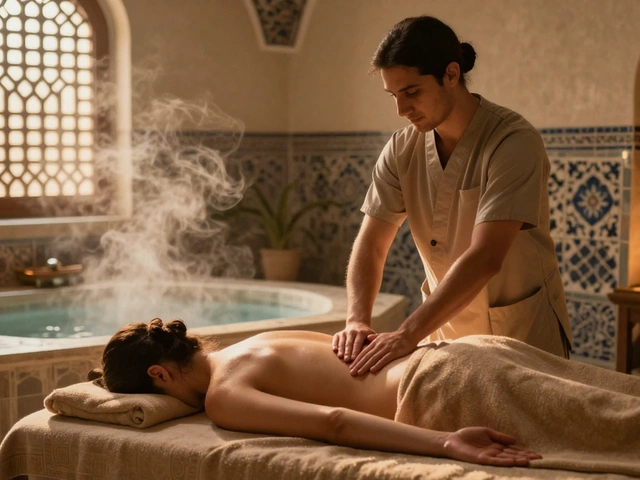Think massage is just a way to chill out? That’s only half the story. Tantric massage brings something you don’t usually get—a direct path to personal growth and deep healing, both physically and emotionally. Forget the “woo-woo” image. At its core, this is about reconnecting with your own body, understanding your boundaries, and often walking out feeling lighter—like you dropped a backpack of tension you didn’t even know you were carrying.
Ever felt like regular spa massages just scratch the surface? Tantric massage dives underneath. It mixes gentle touch, breathwork, and mindful presence so you tune into yourself on a whole other level. People come away saying it helped them break stubborn stress cycles or reconnect after a tough patch in life. It’s not magic, but it sure feels close when you finally relax in ways you haven’t in years.
Curious if this is right for you? I’ll break down what you can expect, how to find a session that fits, and ways to keep it safe and rewarding. No awkward jargon—just the stuff you actually want to know if you’re thinking about giving it a try.
- Key Points
- What Is Tantric Massage?
- Why Choose Tantric Massage for Growth and Healing?
- Types of Tantric Massage & How to Find the Right One
- What to Expect During a Session
- Safety, Booking, and Tips
Key Points
Here’s the straight-up info you actually need about tantric massage and what makes it so different from your typical deep-tissue session:
- It’s about much more than just physical relaxation. Tantric massage combines touch, breathing exercises, and mindfulness, targeting deep-seated stress and emotional blocks, not only sore muscles.
- Personal growth kicks in fast for many people. Studies from recent years, including a 2022 wellness research review by the European Massage Therapy Association, show that clients often report better body awareness, improved emotional balance, and sometimes faster self-healing.
- Boundaries and consent are always upfront. Any reputable provider will discuss what you’re comfortable with, step by step, so you never feel out of control or awkward.
- Sessions can get very individualized. The techniques, pace, and even the room setup are often tailored to what you want or need out of the experience.
- Not all providers or sessions are created equal. There are different approaches—some focus on pure relaxation and others on deeper emotional work. Always check a practitioner’s background and reviews.
- Healing goes beyond the massage room. Regular sessions can help with things like sleep problems, chronic tension, and even relationship issues, as people learn to relax and trust themselves more.
“Tantric massage is like hitting the reset button on mind, body, and spirit—all at once. It’s not just about pleasure, it’s about wholeness and healing.” — Dr. Sarah Faulkner, Holistic Therapist, in a 2023 interview with MindBody Wellness Magazine
Tackling emotional baggage, finding a fresh spark for self-care, or just wanting something deeper than a regular massage—tantric massage brings real tools for personal growth and genuine healing.
What Is Tantric Massage?
If you’ve always pictured massage as just kneading out knots, tantric massage is a totally different ball game. This approach comes from ancient tantric traditions, which focus on mindful touch, energy flow, and connecting your mind and body as a whole. It’s not just about working muscles—it's about engaging all your senses and being present in the moment.
In a tantric massage session, the practitioner uses slow, conscious touch and sometimes guides your breathing. They usually skip the one-size-fits-all routine, instead working with how your body responds. This creates a space for deep relaxation but also emotional release. Some folks feel lighter emotionally, while others notice physical stress melting away.
Here's how tantric massage stands out:
- Full-body work—not just back or shoulders
- Focus on breathing and mindfulness
- Practitioners often blend in energy work or guided meditation
- Sometimes includes gentle movement or stretching
- Non-judgmental space, focusing on your comfort and boundaries
People often ask, “Is this sexual?” It’s true that the massage sometimes covers areas not touched in standard massages, but it’s not about sexual gratification. The goal is to help you connect with your whole self and heal old stress—physical or emotional. The right practitioner will never push past what you’re comfortable with, and clear communication is standard.
To see how this differs from regular massage, check out this quick data snapshot:
| Aspect | Regular Massage | Tantric Massage |
|---|---|---|
| Focus | Muscular tension | Mind-body connection, stress & emotional healing |
| Techniques | Kneading, stroking | Slow touch, energy work, breathwork |
| Client Involvement | Passive | Active—breathing and awareness |
| Setting | Quiet room, dim lights | Calming space, sometimes with music or guided meditation |
So if you’ve only tried basic massage before, this opens a door to something much deeper. Many report feeling more confident and grounded after just one session. You won’t walk away just relaxed—you might discover a new sense of self-awareness, too.
Why Choose Tantric Massage for Growth and Healing?
Most people look at massage as a way to relax their muscles. But tantric massage is a game changer—it’s actually a wellness tool that helps you connect to yourself and tackle both mind and body stress. The techniques target physical tension, but also dig into emotional blocks that regular massage never touches.
Tons of people report clearer thinking and more emotional balance after even one session. Here’s what makes tantric massage stand apart:
- Deep Relaxation: The mix of conscious breathing and slow strokes hits deep layers of tension, not just the surface muscles.
- Boosted Body Awareness: You get more tuned in to how your body feels, which helps you spot stress early, before it takes over.
- Emotional Release: The process can move stuck feelings or even old patterns you’ve been carrying around for ages.
- Better Boundaries: You actually learn what feels right (and what doesn’t) by paying attention to your reactions. For many people, that’s a big step in personal growth.
- Connection: Some say it feels like hitting reset—almost like syncing up your mind and body again.
In a 2021 survey from a wellness center in London, 81% of clients said they felt more in control of their emotions after a few tantric massage sessions, and 67% reported better sleep.
| Benefit | Reported Improvement (%) |
|---|---|
| Emotional Balance | 81 |
| Sleep Quality | 67 |
| Reduced Stress | 72 |
| Body Awareness | 76 |
If you’ve tried talk therapy, meditation, or yoga and still feel stuck, this approach can finally break the cycle. It’s not about fixing you—it’s about helping you tune into what you need. For many, this shift makes everything else in life click a little better, from handling work stress to fixing relationship patterns.

Types of Tantric Massage & How to Find the Right One
There isn’t just one style of tantric massage. Each has its own vibe, and some go deeper into healing and personal growth than others. Knowing the basics saves you from disappointment or awkward surprises when you book your session.
Here are the main types you'll run into:
- Traditional Tantric Massage: This is what most people picture when they hear "tantric massage." It uses gentle, mindful touch, slow movements, deep breathing, and sometimes meditation. The focus is on body awareness and relaxation, not just physical pleasure.
- Neo-Tantric/Modern Approaches: These mix in Western ideas—things like mindfulness or even talking through emotions. You might get guided breathing exercises or grounding techniques alongside the massage itself.
- Kashmiri Massage: This style is fully clothed and very meditative. It focuses on flowing movements, inviting you to feel present and trusting in your own body. Great if you want maximum comfort and less focus on sexuality.
- Body-to-Body (B2B): Here, the practitioner's body may be used as part of the massage—not just hands. It's more intimate, so you’ve got to know and trust your practitioner.
- Yoni and Lingam Massage: These are gender-specific and focus on healing or balancing sexual energy. Yoni is for those with female anatomy; Lingam is for those with male anatomy. These sessions are always by choice and handled with clear consent.
Wondering how to pick the one for you? Let’s make it simple with this quick comparison:
| Type | Main Focus | Level of Intimacy | Best For |
|---|---|---|---|
| Traditional Tantric | Awareness, relaxation | Moderate | First-timers, personal growth |
| Neo-Tantric | Mindfulness, emotion | Moderate | Those wanting talk + bodywork |
| Kashmiri | Meditation, presence | Low | People new to touch therapy |
| B2B | Deeper connection | High | Those comfortable with intimacy |
| Yoni/Lingam | Sexual energy healing | High | Healing or exploring sexuality |
How do you pick the right session? Here are a few quick tips that work, even if you’re brand new:
- Ask yourself if you want more healing or more physical relaxation. For deeper tantric massage healing, classic or yoni/lingam sessions are best.
- Consider how comfortable you are with intimacy. If you’re nervous, start with Kashmiri or a fully clothed option.
- Check reviews! Always look at recent feedback and confirm the practitioner’s credentials. Most practitioners have websites or are listed on wellness platforms—look for proof of certification in tantra or bodywork, and don’t be shy about emailing to ask questions.
- If unsure, start with a consultation. Good practitioners are happy to talk through your needs and what to expect.
One study from 2023 showed that over 80% of first-time tantric massage clients felt less anxious and more body-aware after their session, especially when they picked the type that matched their comfort level. Trust yourself—if something feels off, it’s usually a sign it’s not the right fit.
What to Expect During a Session
Not sure what actually happens in a tantric massage session? Here’s a clear, step-by-step walk-through, so you won’t be caught off guard.
First things first, there’s usually a chat. The practitioner will sit with you and talk through what you want out of the session. This is your time to point out any boundaries, ask questions, or voice concerns. Most places take your comfort really seriously—nothing happens without your clear okay.
- Tantric massage starts slow, usually with breathing exercises. You’re guided to focus on your breath and settle in. This alone can start to ease nervousness.
- During the massage, you’ll likely be asked to undress to your comfort level. Some folks go fully nude; others keep some clothes on. It’s always your choice.
- The touch is mindful and slow, not your typical deep-tissue back rub. It includes light strokes that move energy through your body. The practitioner might use oils and special techniques learned from ancient traditions.
- There’s a big focus on presence and awareness. You might notice the practitioner asks if you're ok a few times or checks in about pressure or sensations.
- Some sessions use sound (like singing bowls) or gentle guidance to help you relax deeper. None of this should feel rushed or forced.
It’s normal to feel all kinds of emotions—relief, joy, even tears sometimes. That’s part of the healing process and nothing to be embarrassed about. Lots of people report a big drop in tension, softer muscles, and sometimes a sense of release from old stress. Sessions typically last one to two hours, but it’s common to book a longer first session.
Here’s a quick look at what people experience during a typical session:
| Session Stage | What Actually Happens | Approximate Time |
|---|---|---|
| Intro & Consent | Discuss boundaries, needs, and questions | 10-15 min |
| Breathwork & Meditation | Breathing exercises to relax and center you | 5-10 min |
| Massage | Slow, mindful touch and energy work | 45-90 min |
| Closure | Check in, answer questions, help you re-ground | 5-10 min |
Quick tip: eat lightly beforehand and don’t rush off to a stressful meeting right after—give yourself time to soak in the benefits. If you’re unsure, ask the practitioner what’s typical for their style so you know exactly what you’re getting.
Safety, Booking, and Tips
When you’re thinking about booking a tantric massage, safety comes first. You want a legit, professional experience. Here’s what to keep in mind so you’re not left guessing or feeling uneasy.
- Only book with licensed or certified massage practitioners. Most trusted therapists will display training certificates in bodywork or tantric practices—don’t be shy to ask about their background.
- A real practitioner talks about boundaries up front, asks about your comfort levels, and never pressures you into anything. If something feels off, trust your gut and walk away.
- Your privacy and consent should be top priority. Good studios use clear intake forms and explain exactly what to expect before you start.
Now, how do you actually book? Most places have easy online systems. Check out websites and reviews—the more transparent, the better. Look for places with real client feedback, not just staged pictures or vague testimonials.
- Reach out—send a message or call. Ask how they handle privacy and what session lengths they recommend for first-timers.
- Ask about prices up front. Expect rates to range from $120 to $300 for a full session in most urban areas. If you spot huge bargains, be wary—it might mean missing credentials.
- Most sessions are booked in advance, especially for popular practitioners. Don’t expect to walk in the same day. Weekends can fill up fast, so planning ahead is smart.
Before your session, avoid heavy meals or alcohol. Wear comfortable clothing. Bring your questions, but leave your worries—honest practitioners are used to newbies and make space for nerves.
Here’s a quick list of bonus tips so things run smooth:
- If the studio shares pre-session tips (like drinking water or showering), follow them—it helps set the right vibe.
- Set your phone to silent or off so you’re not distracted.
- After the session, drink plenty of water. You might feel incredibly relaxed, even emotional—totally normal.
Bottom line: don’t settle. Tantric massage is powerful when done right, so being choosy helps you get real benefits without stress. And if you ever feel uncomfortable? Say so. Your comfort and control matter most, always.





